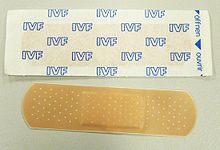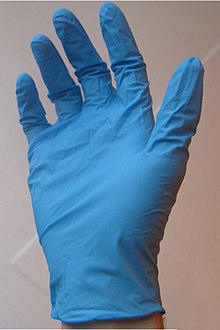First aid kit: Difference between revisions
Lakers244805 (talk | contribs) m fixed links |
Lakers244805 (talk | contribs) No edit summary |
||
| Line 63: | Line 63: | ||
*[[Antiseptics]]/[[antimicrobial]] |
*[[Antiseptics]]/[[antimicrobial]] |
||
**Povidone iodine wipes - very effective and painless, but messy. Can also be used to purify water |
**Povidone iodine wipes - very effective and painless, but messy. Can also be used to purify water |
||
**Benzalkonium Chloride - painless, effective, often includes anesthetic. |
**[[Benzalkonium Chloride]] - painless, effective, often includes anesthetic. |
||
**Alcohol pads - should not be used on open cuts or wounds, since they cause tissue damage and delay healing. They can be used to prep unbroken skin for injections etc. or to disinfect equipment such as thermometers. While not a medical use, alcohol pads are also useful as a solvent to remove ink, adhesives, etc. |
**Alcohol pads - should not be used on open cuts or wounds, since they cause tissue damage and delay healing. They can be used to prep unbroken skin for injections etc. or to disinfect equipment such as thermometers. While not a medical use, alcohol pads are also useful as a solvent to remove ink, adhesives, etc. |
||
**Antibiotic ointment - single, double, or triple antibiotic ointment in petroleum jelly base *Antiseptic/anesthetic ointment or spray |
**Antibiotic ointment - single, double, or triple antibiotic ointment in petroleum jelly base *Antiseptic/anesthetic ointment or spray |
||
*Anti-itch ointment (especially for outdoor kits) |
*Anti-itch ointment (especially for outdoor kits) |
||
**Hydrocortisone cream |
**[[Hydrocortisone]] cream |
||
**Antihistamine cream, such as benadryl |
**[[Antihistamine]] cream, such as benadryl |
||
**Calamine lotion |
**Calamine lotion |
||
*[[Painkillers]] / fever reducers |
*[[Painkillers]] / fever reducers |
||
Revision as of 20:12, 24 February 2008
This article's tone or style may not reflect the encyclopedic tone used on Wikipedia. |

A first-aid box is a collection of supplies and equipment for use in giving first aid, particularly in a medical emergency. Most first-aid kits contain bandages for controlling bleeding, personal protective equipment such as gloves and a breathing barrier for performing rescue breathing and CPR (cardiopulmonary resuscitation), and sometimes instructions on how to perform first aid.
Contents
This article contains instructions, advice, or how-to content. |
Many store bought first-aid kits, especially the cheap ones, are very poor in terms of quality, quantity and selection of items, and are only suited for treating very minor injuries. A homemade kit, if properly prepared, is generally better and sometimes cheaper than most commercial kits.
Many first aid kits attempt to sell a kit comprised of a box of adhesive bandages and a few tablets. How many different type of injuries will this kit treat? Not very many. Don't be fooled by quantity of components, if purchasing a commercially made kit, look for variety of components. The idea is to include components for real life emergencies, not what might let the kit sell for a few dollars less.
A generic first-aid kit is better than nothing. However, the contents of a first-aid kit should be optimized for local conditions. For example, a kit for hikers in snake country should have a snakebite kit. A kit aboard a boat should have medications for seasickness. Consider purchasing an all purpose first aid kit at a quality retail first aid store or online first aid product supplier, and augmenting it with site specific needs for your own expected uses.
One list of items for a first-aid kit are as follows:

- Dressings (sterile, applied directly to wound)
- Pads
- Sterile eye pads
- Sterile gauze pads
- Sterile non-adherent pads
- Burn dressing (sterile pad soaked in a cooling gel)
- Pads
- Bandages (sterility is not necessary, used to secure a dressing)
- Gauze roller bandages - absorbent, breathable, and often elastic
- Elastic bandages - used for sprains, and pressure bandages
- Adhesive, elastic roller bandages - very effective pressure bandages or durable, waterproof bandaging
- Triangular bandages - used as slings, tourniquets, to tie splints, and many other uses
Sometimes dressings and bandages are combined, in which case they must be sterile.
- Adhesive bandages (band-aids, sticking plasters)
- Straight adhesive bandages
- Butterfly (knuckle) bandages

Instruments
- Adhesive tape, hypoallergenic
- Trauma shears, for cutting clothing and general use
- Tweezers
- Lighter, for sterilizing tweezers or pliers etc
- Irrigation syringe, for cleaning wounds
- Rubber suction bulb, for clearing the airway of an unconscious patient
- If treating snakebites is a concern. This is the only snakebite kit generally recognised as not causing further damage and possibly reducing the effects of a snakebite.[citation needed]
Equipment
- Personal Protective Equipment (PPE)
- Gloves, disposable non-latex
- CPR mask or other breathing barrier such as a face shield
- Eye cup or small plastic cup
- Torch (also known as a flashlight)
- Instant-acting chemical cold packs
- Sterile eye wash (commonly saline)
- Sterile saline may also be used for cleaning wounds where clean tap water is not available.
- Swabs, sterile non-woven
- Space blanket (lightweight plastic foil blanket, sometimes called "emergency blanket")
- Alcohol rub (hand sanitizer) or antiseptic hand wipes
- Thermometer
- Penlight
Medication (Single-use packets of medications, ointments, and antiseptics will prolong shelf life, decrease contamination risk, reduce risk of leakage (usually), and save space (for small quantities).
- Antiseptics/antimicrobial
- Povidone iodine wipes - very effective and painless, but messy. Can also be used to purify water
- Benzalkonium Chloride - painless, effective, often includes anesthetic.
- Alcohol pads - should not be used on open cuts or wounds, since they cause tissue damage and delay healing. They can be used to prep unbroken skin for injections etc. or to disinfect equipment such as thermometers. While not a medical use, alcohol pads are also useful as a solvent to remove ink, adhesives, etc.
- Antibiotic ointment - single, double, or triple antibiotic ointment in petroleum jelly base *Antiseptic/anesthetic ointment or spray
- Anti-itch ointment (especially for outdoor kits)
- Hydrocortisone cream
- Antihistamine cream, such as benadryl
- Calamine lotion
- Painkillers / fever reducers
- Acetaminophen
- Ibuprofen - anti-inflammatory, often more effective that acetaminophen.
- Aspirin - Four (4) 81mg Aspirins or one (1) 325mg Aspirin may be given to a person with Chest Pain. The person must not have a allergy to aspirin OR asprin induced asthma.
- Antihistamine - can treat allergies and allergic reactions, including life-threatening anaphylactic shock.
- diphenhydramine (brand name Benadryl)
- Aloe vera gel - used for a wide variety of skin problems, including burns, sunburns, itching, and dry skin
- Burn gel - a water-based gel that acts as a cooling agent and often includes a mild anesthetic such as lidocaine and, sometimes, an antiseptic such as tea tree oil
- Epinephrine auto-injector (brand name Epipen) - often included in kits for wilderness use and in places such as summer camps, to treat anaphylactic shock.
- Poison treatments
- QuikClot is a hemostatic agent sometimes included in first aid kits, especially military kits, to control severe bleeding.
Improvised uses: Many first-aid items can have improvised uses in a survival situation. For example, alcohol pads and petroleum jelly-based ointments can be used as a fire-starting aid in an emergency, and the latter can even be used as an improvised lubricant for certain mechanical devices, and adhesive tapes and bandages can be used for repairs. These alternate uses can be an important consideration when picking items for a kit that may be used in wilderness or survival situations.
Improvisation
First aid can be performed without a first-aid kit. Any cloth (preferably as clean as possible) can be used as a bandage. Duct tape could also be used to secure a dressing. Common household items such as a magazine or even sticks can be used for splints. Direct pressure to stop bleeding can be applied with a hand if nothing else presents itself. Obviously it is better to have proper equipment, but improvised equipment has saved many lives.
Trauma Bag/First Responder Bag
Emergency responders use a more advanced medical kit called a trauma bag or a first responder bag. The contents are more high-quality and the quantity of supplies is more than a basic first-aid kit.
